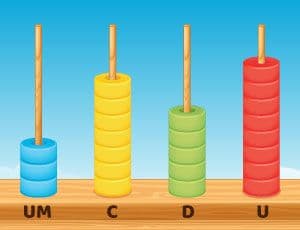Escola Games | Jogos Educativos
https://www.escolagames.com.br
Teacher's support sheet

Online Abacus
What about using the abacus with our students?
The Online Abacus helps students learn mathematics, consolidating the concepts of units, tens, hundreds, and thousands!

Teacher's tips
Level of Education: Elementary School
Subject: Mathematics
Theme: Abacus
Age 07 to 09 years old
Did you know that the abacus was the first calculator man invented? This manipulative object is an instrument with beads representing digits organized in rows. These rows are in the following sequence: units, tens, hundreds, and thousands. We have recreated the traditional abacus online as a fun game that helps students with their necessities while attending to their technological interests. [FIM-DICA]
Learner outcomes
To comprehend basic principles of units, tens, hundreds, and thousands;
To recognize the position of the algorisms on the numbers and the relations between the orders of the number;
To develop numeric thought;
To see the abacus as a learning tool;
To realize that values can be represented in different ways;
To associate quantity with numbers;
To develop logical thinking;
To reinforce the content discussed during the classes;
To learn mathematics in a fun way.
Teachers' goals
To develop students' logical thinking;
To stimulate the following skills: attention, working memory, reasoning abilities, and concentration;
To help the teaching-learning process of the decimal positional number system and the methods to solve the basic operations;
To work with the Montessori method;
To help the development of the motor coordination of the students;
To create an environment that helps students learn mathematics in a fun way.
Suggestions of approaches for the teacher
First, review students' knowledge about the decimal number system and the order of the hundreds, using manipulative materials and even the wood abacus.
Review the four basic operations with a dictation activity.
Then, take the students to the computer lab and show them the game ONLINE ABACUS. Read the instructions along with the students. Play the first round as a test. Write on the whiteboard or a sheet of paper a numeral. Start using only units. Ask them to represent that in the game. After that, write tens, hundreds, and thousands, one by one. When they are representing the thousands, ask for at least six numbers. At each round, see if students need your help and check if they have the correct answers.
In another class, use the ONLINE ABACUS to practice the four basic operations.
Orient students on how to add and subtract the beads in the game because it is essential to optimize time. Start with a unit and then add tens, hundreds, and thousands.
Example:
“3” (they start with three units)
Now, say you want them to represent the number 7. To do that, students must add five units.
Tell them that you want the number twelve. So, they must add a bead on the 'tens' row and leave only two units.
Now, ask them to represent the numbers one hundred and two. They must add one bead on the 'hundreds' row, subtract all the beads on the 'tens' row and leave two beads on the 'units' row.
Now, tell them you want the number one thousand and thirty. To do that, they have to add a bead on the 'thousand' row, one bead on the 'hundred' row, three beads on the 'tens' row, and subtract all the beads on the 'units' row.
Continue doing the activity using subtractions, multiplications, and divisions.
More about the content
You certainly know about the Montessori Method. Montessori teaches mathematics using practical methods to help kids develop respecting their time. A part of the Montessori syllabus involves exposing kids to concrete materials first and then letting them work with abstract concepts. These methods include manipulating the cards and counters materials, using objects of the students to learn fractions, and memorizing essential mathematical facts.
A Montessori classroom has the following characteristics:
Creative environment;
Many stations with materials that enable kids to choose what they want to do, which helps the development of many skills;
Instead of standing in the front of the class, teachers move inside the classroom;
Teachers explore many apprenticeships;
It is focused on social, emotional, intellectual, and physical development;
